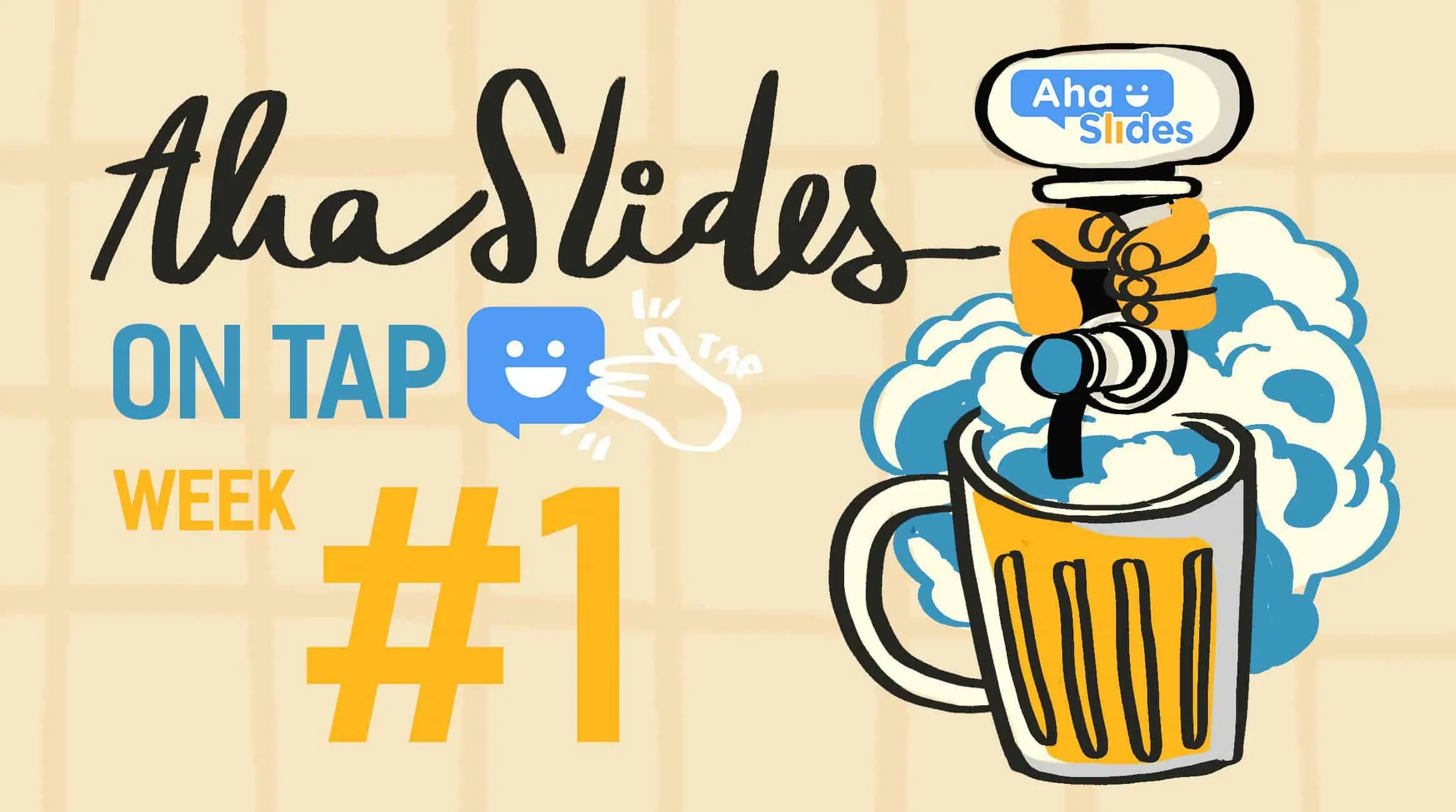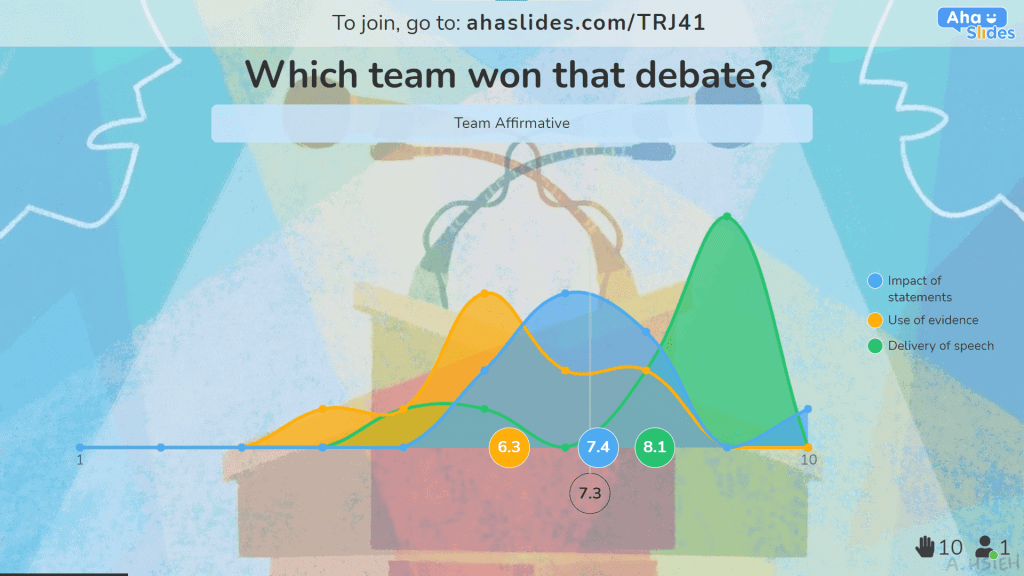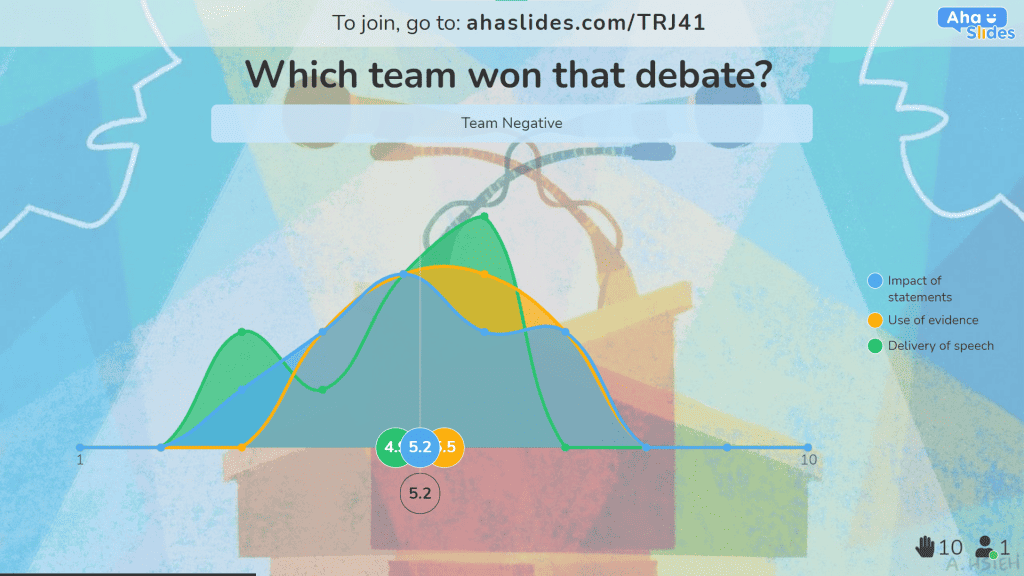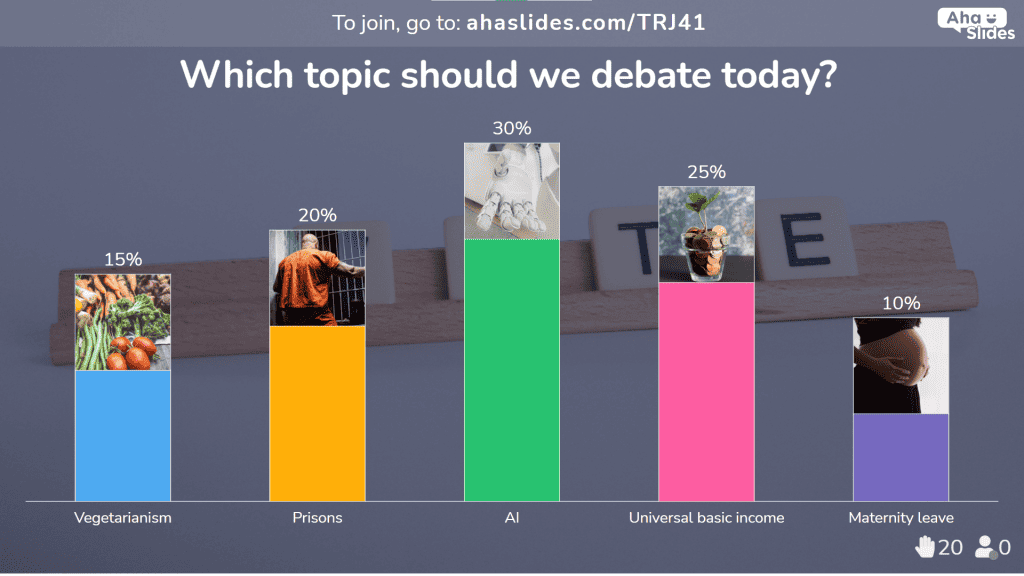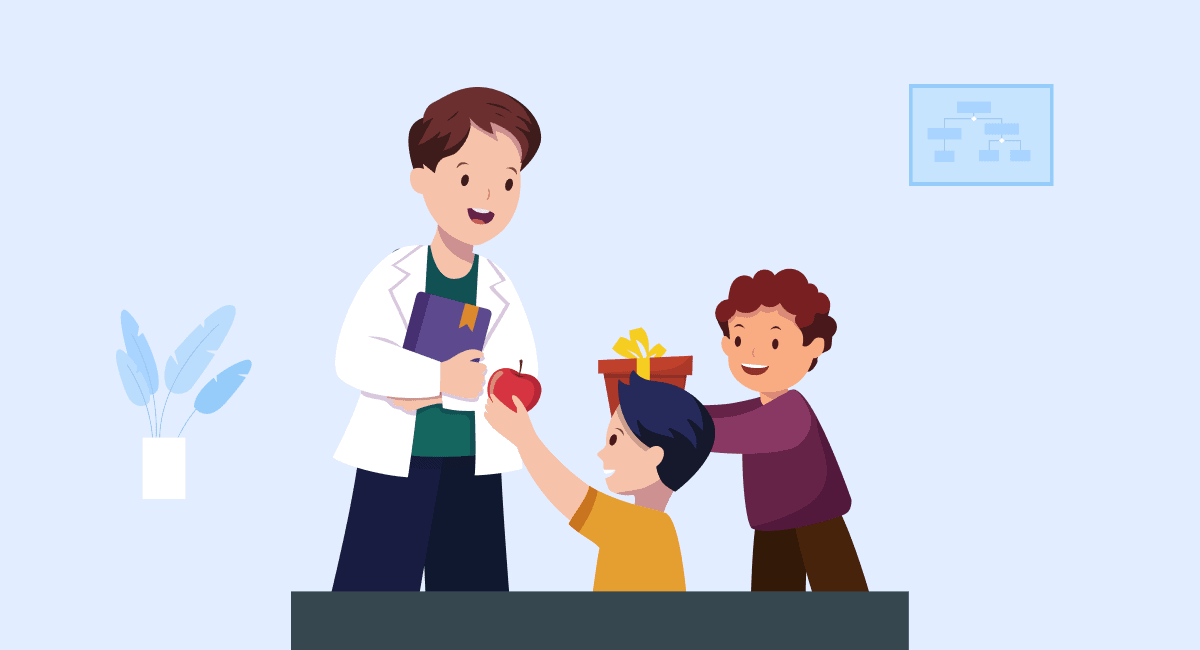여기에는 논쟁의 여지가 없습니다. 학생 토론 비판적 사고를 장려하는 가장 좋은 방법 중 하나입니다. 학생들을 참여시키다 학습자의 손에 학습을 맡기십시오.
그렇다면 학생 토론은 어떻게 진행해야 할까요? 학생 토론은 논쟁적인 수업이나 신진 정치인만을 위한 것이 아니며, 규모가 작거나 성숙한 수업만을 위한 것도 아닙니다. 학생 토론은 누구나 참여할 수 있으며, 학교 교육과정의 핵심으로 자리 잡고 있는 것은 당연한 일입니다.
여기에서 우리는 교실 토론의 세계. 우리는 장점과 다양한 유형의 학생 토론, 주제, 훌륭한 예, 그리고 결정적으로 6 단계로 유익하고 의미있는 수업 토론을 설정하는 방법을 살펴 봅니다.
우리에 대해 자세히 알아보기 대화형 교실 활동!
회사 개요
| 토론은 몇 분 동안 진행해야 하나요? | 5분/세션 |
| 논쟁의 아버지는 누구인가? | 압데라의 프로타고라스 |
| 최초의 토론은 언제였습니까? | 기원전 485-415년 |
AhaSlides를 활용한 더 많은 팁
학생 토론은 어떻게 진행하나요? 목차
- 회사 개요
- AhaSlides를 활용한 더 많은 팁
- 학생 토론에 더 많은 사랑이 필요한 이유
- 학생 토론을 위한 6단계
- 시도해 볼 수 있는 3가지 유형의 학생 토론
- 40개의 학생 토론 주제
- 완벽한 학생 토론 사례
- 자주 묻는 질문들 (FAQ)
학생 토론에 더 많은 사랑이 필요한 이유

수업 중 규칙적인 토론은 학생 삶의 개인적, 직업적 측면 모두에 지대한 영향을 미칠 수 있습니다. 의미 있는 수업 토론이 학생들의 현재와 미래에 매우 가치 있는 투자가 될 수 있는 몇 가지 방법을 소개합니다.
- 설득의 힘 – 학생 토론은 어떤 난관에도 항상 사려 깊고 데이터 중심적인 접근 방식이 필요하다는 것을 학습자들에게 가르칩니다. 학생들은 미래에 매일 발생하는 상황에 도움이 될 수 있는 설득력 있고 균형 잡힌 주장을 구성하는 방법을 배웁니다.
- 관용의 미덕 – 반대로, 수업 시간에 학생 토론을 하는 것은 경청 능력도 향상시킵니다. 학습자들은 자신과 다른 의견에 진심으로 귀 기울이고 그 차이의 원인을 이해하는 법을 배웁니다. 토론에서 지는 것조차도 학생들에게 어떤 문제에 대해 마음을 바꿔도 괜찮다는 것을 깨닫게 해 줍니다.
- 100% 온라인 가능 – 교사들이 여전히 수업 경험을 온라인으로 전환하는 데 어려움을 겪고 있는 상황에서, 학생 토론은 물리적 공간이 필요 없는 편리한 활동을 제공합니다. 물론 개선해야 할 부분도 있지만, 학생 토론을 온라인 수업 방식에 포함시키지 않을 이유는 없습니다.
- 학생 중심 – 과목이 아닌 학생을 학습의 중심에 두는 것의 이점 이미 잘 탐구되었습니다. 학생 토론은 학습자에게 자신이 말하는 내용, 행동 및 반응 방식에 대해 어느 정도 자유로운 통치를 제공합니다.
학생 토론을위한 6 단계
1단계 – 주제 소개
토론 구조에 있어서, 당연히 학교 토론을 진행하는 첫 번째 단계는 토론할 내용을 제공하는 것입니다. 학급 토론의 주제 범위는 사실상 무제한이며 즉석 토론 주제도 마찬가지입니다. 진술을 제공하거나 예/아니오 질문을 할 수 있으며 토론 규칙을 보장하는 한 양측이 진행하도록 하십시오.
그래도 가장 좋은 주제는 반 친구들을 최대한 가운데로 모으는 것입니다. 영감을 얻고 싶다면, 40가지 학생 토론 주제를 확인해 보세요. 아래로.
완벽한 주제를 선택하는 가장 좋은 방법은 학급 내에서 이에 대한 예비 의견 수집, 어느 쪽이 양쪽에 더 많거나 적은 짝수의 학생이 있는지 확인 :
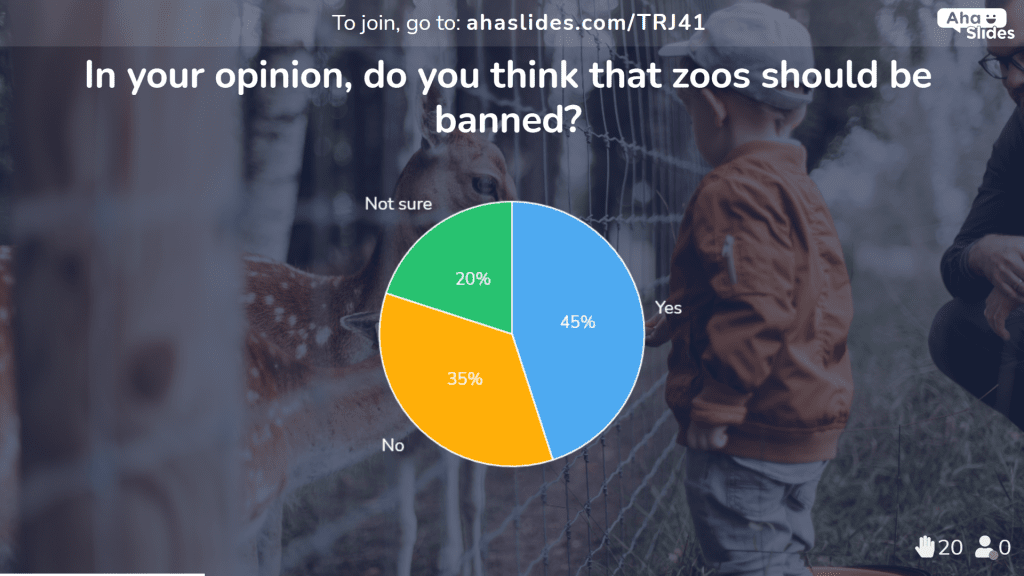
위와 같은 간단한 예 / 아니오 설문 조사는 할 수 있지만, 학생들이 토론 할 주제를 결정하고 설정하는 다른 많은 창의적인 방법이 있습니다.
- 이미지 설문 조사 – 몇 가지 이미지를 제시하고 각 학생이 가장 공감하는 이미지를 찾아보세요.
- 단어 구름 – 학생들이 의견을 표현할 때 얼마나 자주 같은 단어를 사용하는지 살펴보세요.
- 평가 척도 – 점진적으로 점수를 매겨 진술을 제시하고 학생들에게 1에서 5까지 동의도를 평가하게 합니다.
- 개방형 질문 – 학생들에게 주제에 대한 의견을 자유롭게 표현할 수 있는 기회를 제공하세요.
무료 다운로드! ⭐ 아래 무료 AhaSlides 템플릿에서 이 모든 질문을 확인하실 수 있습니다. 학생들은 휴대폰을 통해 실시간으로 질문에 답하고, 전체 학급의 의견에 대한 시각화된 데이터를 확인할 수 있습니다.
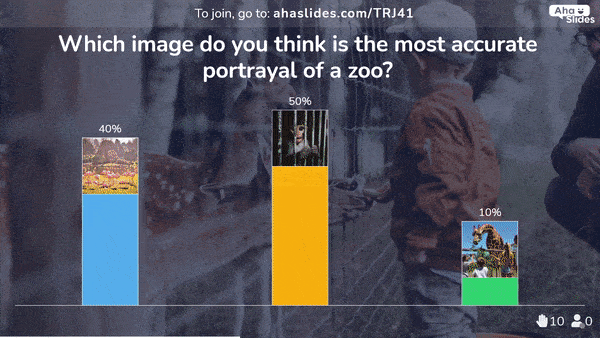
AhaSlides가 바닥을 엽니다.
이 무료 대화형 템플릿을 사용하여 수업 시간에 학생들의 의견을 실시간으로 수집하십시오. 의미 있는 토론을 시작하세요. 가입이 필요하지 않습니다!
무료 템플릿을 받아보세요! ☁️
2단계 – 팀 생성 및 역할 결정
가방에 주제가 있는 경우 다음 단계는 이를 논의하는 2면을 구성하는 것입니다. 토론에서 이러한 측면은 긍정의 그리고 부정.
- 팀 긍정 – 제안된 진술에 동의하는 측(또는 제안된 질문에 '예'라고 투표하는 측)은 일반적으로 현 상태에 대한 변화를 의미합니다.
- 팀 네거티브 – 해당 측은 제안된 성명에 동의하지 않으며(또는 제안된 질문에 '아니오'라고 투표함) 현재 상황을 그대로 유지하고 싶어합니다.
사실, 최소한 두 가지 측면이 필요합니다. 학급 규모가 크거나 긍정적이든 부정적이든 어느 쪽에도 전적으로 동의하지 않는 학생이 상당히 많다면, 팀 수를 늘려 학습 잠재력을 확장할 수 있습니다.
- 팀 미들 그라운드 – 어느 쪽이든 현상 유지를 원하지만, 어떤 면에서는 그대로 유지하고 싶어 합니다. 양측의 주장을 반박하고 양측의 타협점을 찾으려 할 수 있습니다.
팁 #1 💡 중립적인 태도를 보이는 사람들을 벌하지 마세요. 학생 토론을 하는 이유 중 하나는 학생들이 자신의 의견을 더 자신감 있게 표현하도록 하는 것이지만, 때로는 진짜 중간에그들이 이런 입장을 취하게 두세요. 하지만 그것이 논쟁에서 빠져나갈 수 있는 방법은 아니라는 걸 알아야 합니다.
나머지 수업은 판사. 그들은 토론의 각 요점을 듣고 각 팀의 전반적인 성과를 평가할 것입니다. 스코어링 시스템 나중에 출발합니다.
각 발표자의 팀 역할은 원하는 대로 설정할 수 있습니다. 수업 중 학생 토론에서 인기 있는 형식 중 하나는 영국 의회에서 사용되는 형식입니다.
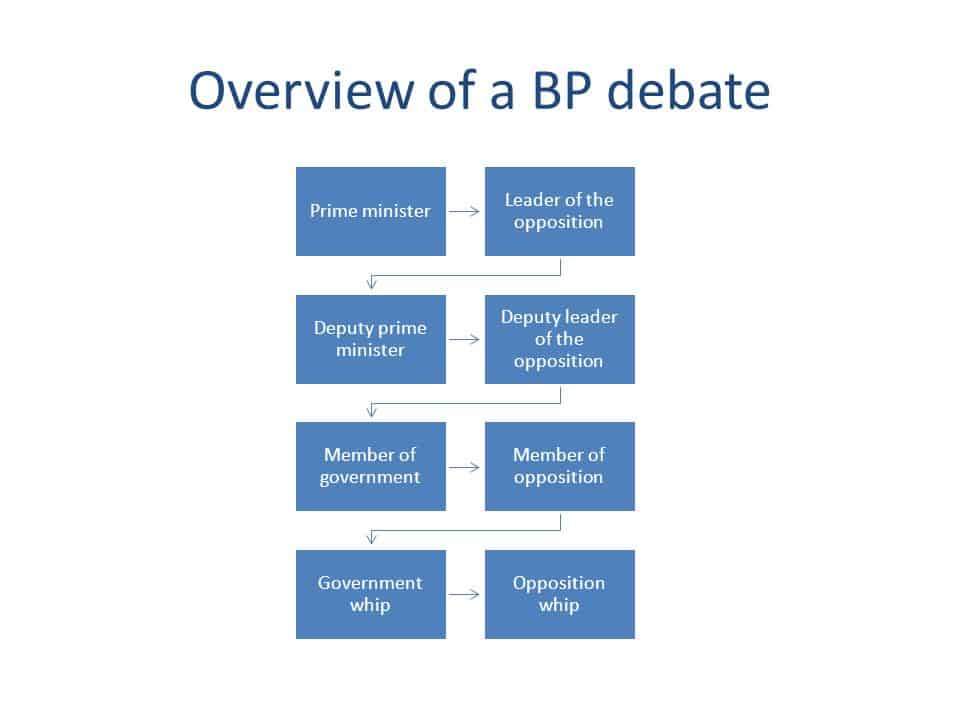
여기에는 각 팀에 4 명의 연사가 포함되지만 각 역할에 두 명의 학생을 할당하고 할당 된 시간 동안 각 학생에게 XNUMX 점을 부여하여 더 큰 수업으로 확장 할 수 있습니다.
3단계 – 작동 방식 설명
시작하기 전에 명확하게해야하는 학생 토론의 세 가지 중요한 부분이 있습니다. 이것은 당신이 경험할 수있는 무정부 적 논쟁의 종류에 대한 당신의 바리케이드입니다. 실제 영국 의회. 그리고 논쟁의 중요한 부분은 구조Walk Through California 프로그램, 규칙 그리고 스코어링 시스템.
— 구조 —
학생 토론은 무엇보다도 탄탄한 구조를 갖추고 토론 지침을 준수해야 합니다. 그럴 필요가있다 옆의 아무도 서로에 대해 이야기할 수 없도록 하고 적절한 허용이 필요합니다. 시간 학습자가 자신의 포인트를 만들 수 있습니다.
이 예제 학생 토론의 구조를 확인하십시오. 토론은 항상 Team Affirmative로 시작하고 Team Negative가 이어집니다.
| 팀 긍정 | 팀 네거티브 | 팀별 시간 수당 |
| 개시 진술 첫 번째 스피커. 제안 된 변경 사항에 대한 주요 지원 사항을 설명합니다. | 개시 진술 첫 번째 스피커. 제안 된 변경 사항에 대한 주요 지원 사항을 설명합니다. | 5 분 |
| 반박 준비. | 반박 준비. | 3 분 |
| 반박 두 번째 발표자는 Negative 팀의 모두 발언에서 제시된 요점에 대해 반박할 것입니다. | 반박 두 번째 발표자는 Affirmative 팀의 모두 발언에서 제시된 요점에 대해 반박할 것입니다. | 3 분 |
| 두 번째 반박 세 번째 발표자가 Negative 팀의 반박에 반박할 것입니다. | 두 번째 반박 세 번째 발표자가 Affirmative 팀의 반박에 반박할 것입니다. | 3 분 |
| 반박 및 마무리 진술을 준비합니다. | 반박 및 마무리 진술을 준비합니다. | 5 분 |
| 최종 반박 및 종결 진술 네 번째 스피커에서. | 최종 반박 및 종결 진술 네 번째 스피커에서. | 5 분 |
팁 #2 💡 학생 토론의 구조는 효과가 있는 것을 실험하는 동안 유연할 수 있지만 돌로 설정해야 최종 구조가 결정되면 시간을 잘 확인하고 발표자가 정해진 시간을 넘기지 않도록 주의하세요.
— 규칙 —
규칙의 엄격함은 수업 시작 발표를 듣는 순간 학생들이 정치인들로 흩어질 가능성에 달려 있습니다. 하지만 누구를 가르치든 지나치게 목소리를 높이는 학생들과 목소리를 내지 않으려는 학생들은 항상 있을 것입니다. 명확한 규칙은 공평한 경쟁의 장을 마련하고 모든 학생의 참여를 장려하는 데 도움이 됩니다.
수업 토론에 사용할 만한 몇 가지 예는 다음과 같습니다.
- 규칙을 잘 지키세요! 자기 차례가 아닐 때는 말하지 마세요.
- 주제에 집중하십시오.
- 욕하지 마세요.
- 인신 공격에 의지하지 않습니다.
— 채점 시스템 —
교실 토론의 요점은 실제로 '이기는 것'이 아니지만, 학생들의 자연스러운 경쟁심이 어느 정도 점수를 기반으로 한 달래기를 요구한다는 것을 알게 될 것입니다.
...에 대해 포인트를 부여할 수 있습니다.
- 영향력있는 진술
- 데이터 기반 증거
- Eloquent Delivery
- 강한 신체 언어
- 관련 영상 사용
- 주제에 대한 진정한 이해
물론 토론을 판단하는 것은 결코 순수한 숫자의 게임이 아닙니다. 귀하 또는 귀하의 심사위원단은 토론의 각 측면에 점수를 매기기 위해 최고의 분석 기술을 끌어내야 합니다.
팁 #3 💡 토론을 위해 ESL 교실, 사용한 언어가 점수보다 훨씬 더 중요한 경우 다양한 문법 구조 및 고급 어휘와 같은 기준을 보상해야 합니다. 동시에 모국어 사용에 대한 감점도 가능합니다.
4단계 – 조사하고 글을 쓸 시간

모두 주제와 수업 토론 규칙을 이해하셨나요? 좋습니다! 이제 주장을 준비할 시간입니다.
여기서해야 할 일은 시간 제한 설정 연구를 위해 일부 레이아웃 미리 결정된 소스 정보그리고 학생들이 다음과 같은지 모니터링합니다. 주제에 집중.
그들은 자신의 요점을 조사하고 엉뚱한 생각 상대 팀의 반박 가능성을 예측하고, 그에 대한 대응 방안을 결정해야 합니다. 마찬가지로, 상대 팀의 주장을 예상하고 반박 가능성을 고려해야 합니다.
5단계 – 방(또는 줌) 준비
각 팀이 포인트를 확정하는 동안, 이제 쇼를 준비할 시간입니다.
테이블과 의자를 방 건너편에 마주보도록 배치하여 전문가 토론 분위기를 최대한 재현해 보세요. 일반적으로 발표자는 테이블 앞 단상에 서서 발표를 마치면 다시 테이블로 돌아갑니다.
물론, 온라인에서 학생 토론을 주최하는 것은 조금 더 어려울 수 있습니다. 그래도 몇 가지 재미있는 방법이 있습니다. Zoom에서 팀 차별화:
- 각 팀이 생각해 내도록합니다. 팀 색상 그리고 Zoom 배경을 장식하거나 유니폼으로 착용하기도 합니다.
- 각 팀이 팀 마스코트 토론하는 동안 각 구성원이 화면에 표시합니다.
6단계 - 토론하세요!
전투를 시작하세요!
지금이 학생이 빛날 시간이라는 것을 기억하세요. 최대한 끼어들지 않도록 하세요. 말을 해야 한다면, 수업 질서를 유지하거나 수업 구조나 채점 시스템을 전달하기 위한 것이어야 합니다. 그리고 몇 가지 팁을 알려드리겠습니다. 소개 예 당신이 토론을 흔들어 놓을 수 있도록!
채점 시스템에 명시된 기준에 따라 각 팀의 점수를 매겨 토론을 마무리하세요. 심사위원은 토론 내내 각 기준에 대한 점수를 기입할 수 있으며, 이후 점수를 합산하여 각 막대의 평균 점수가 팀의 최종 점수가 됩니다.
팁 #4 💡 심도 있는 토론 분석으로 바로 뛰어들고 싶은 유혹이 들 수도 있지만, 이것은 다음 수업까지 저장하는 것이 가장 좋습니다.. 학생들이 긴장을 풀고 요점을 생각하고 다음에 다시 와서 분석하게하십시오.
시도 할 다양한 유형의 학생 토론
위의 구조는 때때로 Lincoln-Douglas 형식에이브러햄 링컨과 스티븐 더글러스 사이의 일련의 격렬한 토론으로 유명해졌습니다. 하지만 수업 중 토론을 할 때 탱고를 추는 방법은 여러 가지가 있습니다.
- 역할극 토론 – 학생들은 가상의 인물이나 가상의 인물의 의견을 바탕으로 토론을 진행합니다. 이는 학생들이 마음을 열고 자신과 다른 관점을 가진 설득력 있는 주장을 펼치도록 유도하는 좋은 방법입니다.
- 즉석 토론 – 즉흥 퀴즈를 생각해 보세요. 토론을 위한 퀴즈죠! 즉흥적인 학생 토론은 발표자들이 준비할 시간을 주지 않기 때문에 즉흥적이고 비판적인 사고 능력을 키우는 좋은 연습이 됩니다.
- 타운 홀 토론 – 두 명 이상의 학생이 청중을 마주 보고 질문에 답합니다. 각 측은 각 질문에 답할 기회를 얻고, 어느 정도 예의를 갖춘다면 서로 반박할 수 있습니다!
최고의 13가지 놀라운 것을 확인하세요 온라인 토론 게임 모든 연령대의 학생을 위한 (+30개 주제)!

학생들을 참여시킬 더 많은 방법이 필요하십니까? 💡 확인하세요 12 가지 학생 참여 아이디어 아니면 그 뒤집힌 교실 실시간 및 온라인 수업을 위한 기술!
40가지 학생 토론 주제
토론을 교실 바닥으로 가져올 영감을 찾고 계십니까? 아래의 40가지 학생 토론 주제를 살펴보고 함께 갈 학생들과 함께 투표하십시오.
학생 토론을위한 학교 주제
- 하이브리드 교실을 만들고 원격 및 수업 중 학습을 모두해야합니까?
- 학교에서 교복을 금지해야합니까?
- 숙제를 금지해야합니까?
- 뒤집힌 교실 학습 모델을 시도해 볼까요?
- 밖에서 더 많이 배워야할까요?
- 시험을 폐지하고 과제를 통해 시험을 치러야 할까요?
- 모두가 대학에 가야합니까?
- 대학 학비를 낮추어야합니까?
- 투자 강의를해야합니까?
- e 스포츠가 체육 수업에 포함되어야합니까?
학생 토론을위한 환경 주제
- 동물원을 금지해야합니까?
- 이국적인 고양이를 애완 동물로 키워도 되나요?
- 더 많은 원자력 발전소를 건설해야합니까?
- 전 세계적으로 출산율을 낮추려고 노력해야합니까?
- 금지해야할까요 모든 일회용 플라스틱?
- 개인 잔디밭을 할당량과 야생 동물 서식지로 바꿔야할까요?
- 우리는 '환경을 위한 국제 정부'를 시작해야 할까요?
- 사람들에게 기후 변화에 맞서기위한 방법을 바꾸도록 강요해야합니까?
- '패스트 패션'을 억제해야 할까?
- 기차와 버스 시스템이 좋은 작은 나라에서 국내선을 금지해야합니까?
학생 토론을위한 사회 주제
- 우리가 모든 채식주의 자입니까, 비건입니까?
- 비디오 게임 플레이 시간을 제한해야합니까?
- 소셜 미디어 사용 시간을 제한해야 합니까?
- 모든 욕실을 성 중립적으로 만들어야합니까?
- 표준 출산 휴가 기간을 연장해야합니까?
- 할 수있는 AI를 계속 발명해야합니까? 모든 직업?
- 우리는 보편적 기본 소득을 가져야 하는가?
- 감옥은 처벌을 위한 것인가, 재활을 위한 것인가?
- 사회 신용 시스템을 채택해야합니까?
- 데이터를 사용하는 광고를 금지해야합니까?
학생 토론을위한 가설 주제
- 불멸이 선택 사항이라면 그것을 받아들이겠습니까?
- 도둑질이 합법적이라면 그렇게 하시겠습니까?
- 동물을 쉽고 저렴하게 복제 할 수 있다면 그렇게해야합니까?
- 하나의 백신이 예방할 수 있다면 모든 전염성 질병인데, 사람들에게 강제로 복용하게 해야 할까요?
- 지구와 같은 다른 행성으로 쉽게 이동할 수 있다면 그렇게 해야 할까요?
- If 아니 동물은 멸종 위기에 처해있었습니다. 모든 동물의 사육이 합법적이어야합니까?
- 일을하지 않고 편안하게 살 수 있다면?
- 세계 어느 곳에서나 편안하게 살 수 있다면 내일 이사 하시겠습니까?
- 강아지를 사거나 나이가 많은 개를 입양 할 수 있다면 어느 쪽을 선택 하시겠습니까?
- 외식이 스스로 요리하는 것과 같은 가격이라면 매일 외식 하시겠습니까?
학생들에게 이러한 토론 주제를 선택하면 어떤 주제를 바닥으로 가져갈 지 최종 결정을 내릴 수 있습니다. 이를 위해 간단한 여론 조사를 사용하거나 각 주제의 특성에 대해 더 미묘한 질문을하여 학생들이 어떤 주제에 대해 가장 편안하게 토론하는지 확인할 수 있습니다.
학생들에게 무료로 설문 조사를하십시오! ⭐ AhaSlides는 실시간 투표, 퀴즈, 아이디어 교환을 통해 학생들을 수업의 중심에 두고 의견을 제시할 수 있도록 도와줍니다. 학생 참여도 향상 측면에서는 논쟁의 여지가 없습니다.
완벽한 학생 토론의 예
한국 방송 네트워크 아리랑에서 방영된 학생 토론의 가장 훌륭한 사례 중 하나를 보여드리겠습니다. 지능 – 고등학교 토론, 교사가 교실에 가져와야 할 아름다운 학생 토론의 거의 모든 측면이 있습니다.
확인 해봐:
팁 #5 💡 기대치를 조절하세요. 이 프로그램의 아이들은 정말 훌륭하고, 많은 아이들이 영어를 모국어로 사용하면서도 유창하게 토론합니다. 학생들이 같은 수준이기를 기대하지 마세요. 필수 참여는 좋은 시작입니다!

학생들에게 의견을 표명하세요.
설문조사와 퀴즈를 통해 학생들의 참여를 유도하고, 토론을 통해 학급 분위기를 발전시키세요. AhaSlides는 교실을 상호작용적으로 만들고 학생들에게 주도권을 부여합니다.
무료로 체험해보세요 ☁️
자주 묻는 질문들 (FAQ)
궁금한 점이 있으신가요? 답변해 드리겠습니다.
